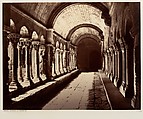Arles, Cloitre St. Trophime
Edouard Baldus French, born Prussia
Not on view
The twelfth-century cloister of the Church of Saint-Trophîme in Arles, noted for its richly carved capitals, ranks among the most important examples of French medieval architecture, and was among the sites that Baldus first photographed on his 1851 "mission héliographique." In the context of the "Paris-Lyon-Méditerranée" album, this picture's tunneling perspective and the repetition of arches link the famous cloister to the achievements of Second Empire engineers--to the railroad tunnels and arched viaducts that are presented in a similar fashion elsewhere in the volume.
Proper exposure of a scene that included both shadowed interior and sunlit exterior presented a difficult task. Careful scrutiny of the print reveals that Baldus used thin tissue overlays on the most transparent sections of the glass negative so as not to lose all detail in the darkest parts of the print. In addition, light washes of watercolor or ink were used to give tone to some of the lightest areas and to define the cloister colonnade.
Due to rights restrictions, this image cannot be enlarged, viewed at full screen, or downloaded.


